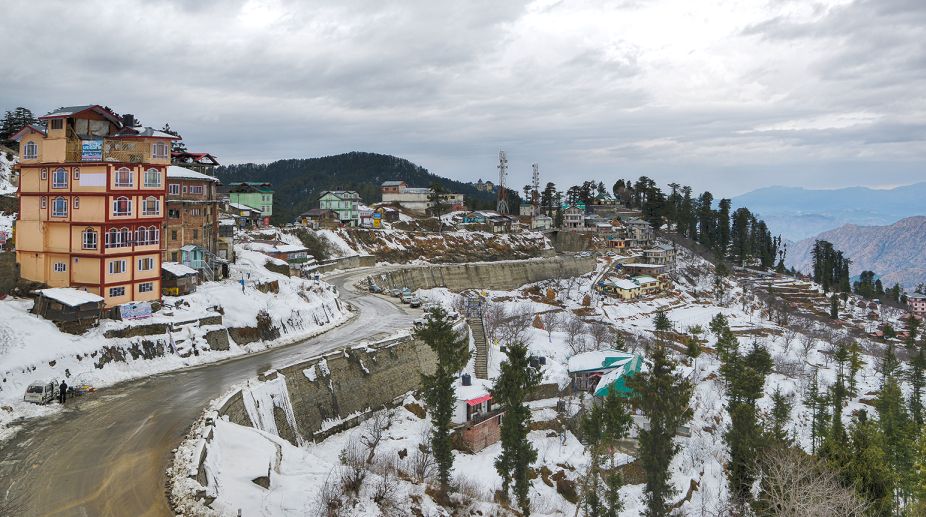There are a few places in India I visit multiple times, mainly because of emotional attachments, and Shimla is one as it harbours a familial relation in addition. In the early 20th century, my grandfather and his cousin brother were railway employees posted in Delhi. At the time, most British government offices, including the Railways, used to shift to the summer capital of Shimla in order to escape from the atrocious Delhi heat, owing to which, my grandfathers were stationed there for almost half a year.
Along with some other Bengali friends, they established a Kali temple at Shimla, derived from Shyamla Devi, her other incarnation, which is presently the famous Kali Bari, where our family members used to stay whenever they visited.
It is preferable to travel by train from Kalka to Shimla and experience the colourful sceneries against the backdrop of verdant hills. Commissioned in 1906 this Kalka-Shimla rail line navigates 103 tunnels and 806 bridges, which along with waterfalls on the way are the most enjoyable during a lethargic train journey. People also have the liberty to get down and take a stroll whenever the train halts.
This time, however, I had to travel by bus from Chandigarh. Almost the entire road was rather uncomfortable; either due to repairing or levelling the hill slopes for construction.
As a result, a thick layer of dust hung mid-air blocking the sun and wind. Though situated at a height of 2,276 metres, Shimla hardly experiences cold temperatures till the end of November after which nights get especially intolerable. However, the Ridge and Mall Road, the centres of the hill town, was bursting with life owing to both tourists and locals.
Rows of winter wear shops, curios and eateries were lined up on either side. And drinking coffee till late at the Mall is a fantastic experience!
From Jakhu Temple, one can also get a panoramic view of Shimla as it is located on the highest peak in the area.
I also happened to visit the Indian Institute of Advanced Studies, one of the prime educational institutes in our country. The colonial style building of Viceregal Lodge stood out due to its historical importance. Built as a home for Lord Dufferin, the viceroy from 1884-88, it housed all the subsequent viceroys and governor generals, and after Independence, the President of India.
In 1965 Dr S Radhakrishnan turned it into the advanced study centre. A gallery comprising the historical photographs and memorabilia including the Simla Accord of 1914 and Simla Conference of 1945 is worth viewing. Some others like Tudorbethan and new gothic-styled buildings like Auckland House, Gorton Castle, Gaitey Theatre and Town hall are still standing, lingering in its flavour of the British era. The Christ Church is another spectacular landmark on the Ridge. The Indian Army Museum and an adjacent green plain exhibit the quintessential warring nature of humans.
Travelling through the hills and valleys of the Himalayas from Shimla to Manali took me back to the days of my youth when I enjoyed such journeys along the river Beas. After crossing the Kullu valley the sky became clear of dust and the sun was finally visible.
The mesmerising night sky was completely dotted with sparkling diamonds and all the constellations could be effortlessly located.
Our accommodation was at the confluence of the rivers Beas and Arup and hence we could experience the music of Jaltaranga that was soothing to the ears.
What was once said to be the Manu-Alaya, the abode of the Hindu lawgiver Manu, Manali is now one of the most attractive tourist spots in this part of the Himalayas. There are plenty of apple trees in this Beas River valley as well as thick forests of pine and cedar.
Walking through such a forest and listening to the whistles of birds against the music of the flowing Beas in the backdrop was an exceptional experience to be cherished.
Exotic Kullu shawls and other warm dresses are the main items of business among the tourists at the Mall and temples of Vashisht, Hirhimba, Ghatotkoch, among others are located in the surroundings. About 30 kilometres from there in the valley of River Parvati, Manikaran is situated — a pilgrimage site for both the Hindu and Sikh communities. It is also famous for the hot spring that flows into the river.
Thereafter, a picturesque 50 kilometre journey towards Ladakh from Manali took me through Rohtang Pass, a natural divide between the Kullu and Lahul-Spiti Valley. I saw the source of the Beas as the river emerges from below the surface and flows southward. The Chenab and Chandra rivers also originate on from Rohtang Pass.











